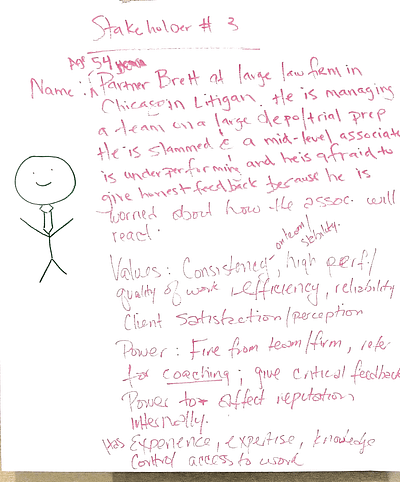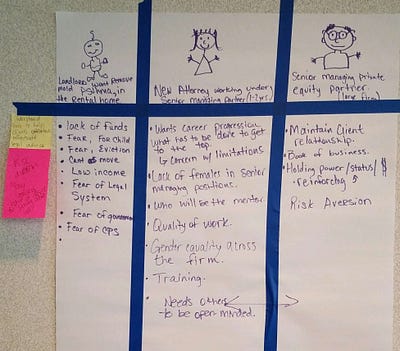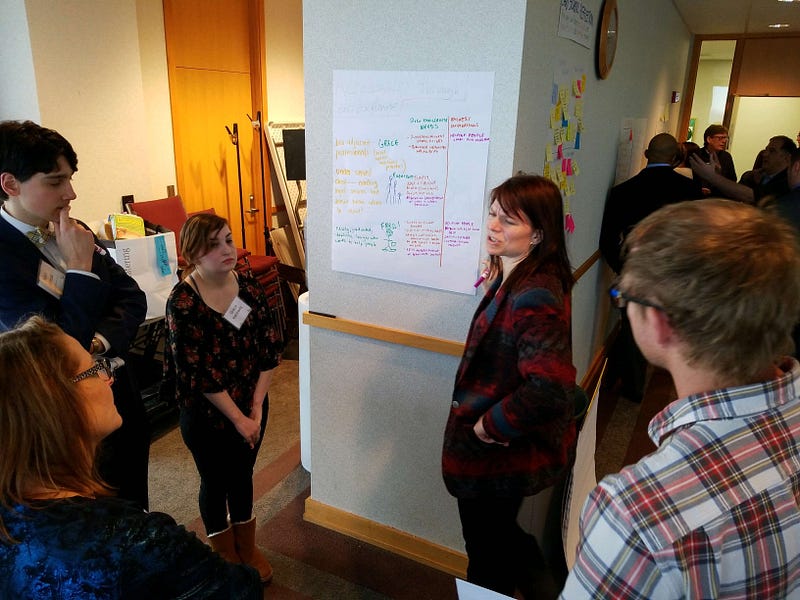This piece was originally posted on the Lab’s Medium publication, Legal Design and Innovation.
Building a Better Lawyer

In February 2018, Michigan State’s Legal RnD and Stanford University’s Legal Design Lab co-hosted a workshop on Building a Better Lawyer, with support from Thomson Reuters.
Workshop participants came from corporate legal departments, law firms, courts, law schools, start-ups, legal publishers, and legal technology companies. The participants worked in small teams, using design thinking methodology and lean process, on the challenge of:
How can we improve how lawyers are trained, and how they serve the client and public?
As facilitated by the team from Michigan State and Stanford groups, the teams identified key problems, opportunities, and target stakeholders. They then brainstormed, prioritized, and vetted a handful of ideas for new initiatives. The goal of the session was to have diverse participants surface key points to focus on, and to generate an agenda for change.
This piece summarizes the insights and ideas that emerged from the innovation sprint. It also reflects the discussions that emerged after the sprint, that synthesize the work and identify takeaways, big visions, and near-term pilots. We present them here for review and further action.

8 Big Ideas for Building a Better Lawyer
The main goal of the workshop was to generate a set of near-term proposals for how law school could better improve graduates to practice, and to improve the profession. We challenged the teams to be ambitious yet practical — to come up with new concepts for building a better lawyer that might be feasible within the next five years.
Each of the teams spent the afternoon drafting, testing, and refining a proposal for a new way to train lawyers or deliver services. The shortlist of ideas that emerged from the teams are as follows:
1.A Problem-Solving Law School. Lawyers tend to fight and not to conciliate or collaborate. This should be learned through experiential training with a project-based methodology. This might be an entirely new track or type of law school, that aims towards creative problem-solving and dispute prevention and resolution — as opposed to adversarial approaches.
2.Scenario training. Train lawyers and students through realistic, fictional scenarios in which, over the course of a few days, they work with a team to tackle a complex challenge and are evaluated for their performance. This is already being done by some law firms (Allen & Overy and Fenwick & West have some scenario training around international deals). The proposal here is to draft real-life cases into multi-day simulations that can both be courses and evaluation mechanisms for young lawyers to get practical skills and exposure.
3.Business certification track in law. Create a business certification track in the Law School, to meet the needs of business and law schools by creating lawyers who are better able to work in interdisciplinary business teams. This would involve more teamwork, more quantitative and business modeling skills-building, and more exposure to working with non-lawyers — so that lawyers can begin to think like their business colleagues, and adapt their problem-solving and working styles to better integrate with them.
4.Law-Harmony matchmaking. As an alternative to the OCI model of recruitment and job placement, have a more intentional matchmaking + job-prep process that puts emphasis on matching the skills of law students with employers.
5.Legal Navigator community training. More law schools should offer community members, social service and other analogous service-providers, and self-represented litigants education in the law. This is driven from the access to justice crisis — and the need for more non-lawyer navigators to assist people with family, debt, housing, and work issues. The resources and structures of the law school could be adjusted and packaged for new kinds of training, not for JDs, but for Legal Navigators who could be employed by courts, legal aid groups, hospitals, and others focused on community lawyering.
Post-Workshop Ideas: Near-Term Innovation for Law Schools
After the workshop ended, a few other ideas emerged — -not from the design teams, but out of the conversations after the fact. These ideas were a filtering down of some of the grand designs, to more near-term ways that law schools can improve how they are training young lawyers.
6.Pop-up Classes with Experimental Curriculum. Test run new courses with one or two day versions of the class. Law schools can invite faculty from other schools to come and run classes on specialized or advanced technology. Stanford Law tried this with a Prototyping Blockchain for Law class earlier in 2018, with guest speakers Jeff Ward from Duke and Aaron Wright from Cardozo Law bringing their excellent legal blockchain curriculum to Stanford for an abridged 2-day version.
7.Client Experience Tours. As part of orientation to law school or a new legal job, and also woven throughout classes, there can be a practice of Client Experience Tours. For any given topic matter, whether in doctrinal classes or more advanced ones — or even clinics — there can be an obligation for students to shadow a client throughout their visit to a clinic, a court, or other legal setting. They might also go to the client’s home or work to see the context from which they’re coming. One model for this is the LawX class at BYU, which included home visits to people who were dealing with debt and credit card lawsuits, so that the students could get the backstory of a person for whom they were creating a new service.
8.Failure Training. With the insight that many young lawyers get stuff wrong, but most don’t admit it — and often suffer professional or personal consequences from keeping their failures to themselves — this proposal aims to help lawyers and law students better acknowledge how they got things wrong. It could be a short-class in a law school, a regular evening casual event (like the professionals-oriented F-up Nights), or an internal set of videos or resources inside a legal org — the main thing is to have lawyers talk to their peers about actual stories of how they did something wrong, what the consequences were, and what they might have done differently. The goal is to get young lawyers to be ready for the many failures that await them, and to lower the stigma of talking about it — so that lawyers are more likely to tell their peers and bosses when they did something wrong.
Some Bonus (Non-Law School) Innovation Ideas
Not all groups stayed within the law school-redesign ambit — and took on wider ambitions about how to build better lawyers and improve services to people in need of legal help.
An emergent lawyer referral system. Have State Bars help organize a more robust network of lawyers for a referral system that truly serves people with legal needs — finding them a great fit, and also helping lawyers to develop their practice and client relationships.
Relocated Community Courts. One group advocated a new approach to court services — where dispute resolution and legal/clerical services would be out of government buildings, and more centrally located in public transport, gym, coffee shops, libraries, and other community locations.
The Process + Insights Behind the Ideas
Where did these ideas emerge from? We spent the morning of the workshop mapping out anecdotes, data points, trends, and hypotheses around 4 main themes: (1) Community and Market Needs; (2) Reflections on Law School; (3) The Ideal Lawyer; and (4) Innovations in Law Schools. We had stations around the room in which participants could discuss these 4 themes, leave comments, and make proposals around them.

From there, we pulled out some of the major themes that emerged:
- Law graduates and innovation-oriented organizations need better ways to find and influence each other, with more ‘disintermediated’ career services. It should be easier for like-minded law grads and companies to find each other and work with each other.
- Law students should have more varied and numerous client-oriented experiences in law schools..
- Law schools need to provide more strategic training.
- Failure and resilience must be taught and prepared for earlier in lawyers careers.
- There needs to be more explicit education around Collaborative Lawyering.
- The State Bar can be a rich partner for a more data-driven agenda on needs and futures of lawyers, as well as access to justice initiatives.
- We need more lightweight legal education of social workers, public servants, and community members, so there can be a broader network of professionals certified in legal support.
- Lawyers should explore ways to retrofit existing community spaces with legal resources and resolution centers, to get more legal help in places people will find and trust them.


What’s going well in law schools + other lawyer training
Some of the current positives that the participants highlighted are
- Recognition that change is needed. Law schools recognize that new skills are needed for the alternative roles that younger lawyers are taking after law school. Because of this, Law Schools are starting to teach different ways of thinking and the rise of innovation labs is a proof of this.
- Rise of the practice lawyer. Law Schools have been increasing their focus on clinics and real world application of the Law. Students are eager to learn by doing (not only from books) prior to work in a law firm or in other legal career path.
- Law firms are beginning to recognize the need to change. The rise of emerging technology tools, and the broad spectrum of employers and practices have incentivized law firms to invest in teaching. Younger lawyers are eager to continue studying while practicing at a Law firm.
What could be better in the legal ecosystem
Many ideas of what could be better in the legal ecosystem emerged:
- Law school’s administration. Law Schools could be seen as labs where new ideas could be prototyped and implemented. Some of these ideas could include a shared student governance for the school, rewrite the rules of admission, or lowering the debt pressure.
- Rethink the practical training. The career paths and prospects for lawyers have changed during the last decade. Most of the practical training is thought for the classic legal paths. The law schools should begin to train young lawyers for these new career paths.
- Twenty-first century lawyers. Lawyers should be better positioned for the client’s needs. The T-shaped lawyer is an example to tackle this because it requires the lawyer to communicate and collaborate across disciplines, with a knowledge and skills in different subjects. Law Schools could consider lawyers as entrepreneurs and teach them all the skills they would need. The pace of technology in other verticals will validate and drive innovation in the legal career. Law Schools could consider dual programs in which they integrate emerging technologies such as artificial intelligence.
- Data-driven law firms. Legal departments can set pressure on metrics from the law firms. This could result in a better feedback from the companies.

Who can lead Better Lawyer efforts?
One other set of insights emerged from the groups — they identified the main stakeholders who should be at the heart of law school innovation. The groups all laid out the key people in the law school, legal department, state Bar, and law firm circles who could be key people to tap into, to build better lawyers.

From the different teams’ work, there was noticeable convergence around a short list of stakeholders that future legal innovation initiatives should target. There were also some unique stakeholders that single teams proposed. The proposed focus points included, from most prominent to least:
- Law Students, and recently graduated young lawyers
- Partners, associates, managing partners, and hiring associates in law firms
- Law Schools’ deans, career services, and academic deans
- General Counsel of legal departments
- Bar leaders and delegates
- Small Business Owners, Self-Represented Litigants, and other Clients
- Law-Adjacent professionals, like social workers










Conclusion
- Innovation and change of the legal profession is a task that should be tackled by the whole legal ecosystem: law schools, law firms, the State Bars, legal departments, and beyond — including litigants in the mix as well.
- New soft skills should be taught to law students in order to prepare lawyers with a different mindset. These soft skills should teach law students to think in a more collaborative way (not just to battle), increase problem-solving capabilities, and resilience.
- Law Schools should encourage a flexible curriculum with different type of courses and practice training. These could include pop-up courses, shadow learning training, and purpose driven classes with clients.
- The State Bar can (and should) play a key role in the future of the Legal Profession through a data-driven agenda of the new ways to practice law.




